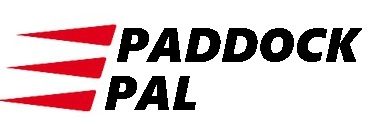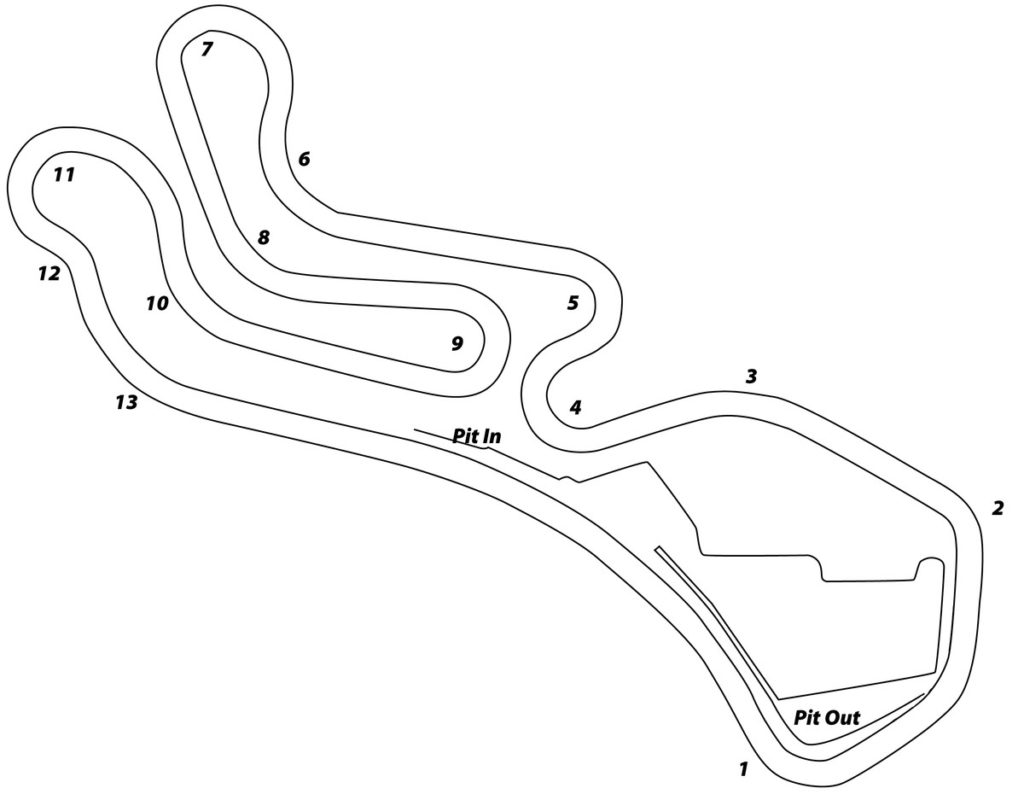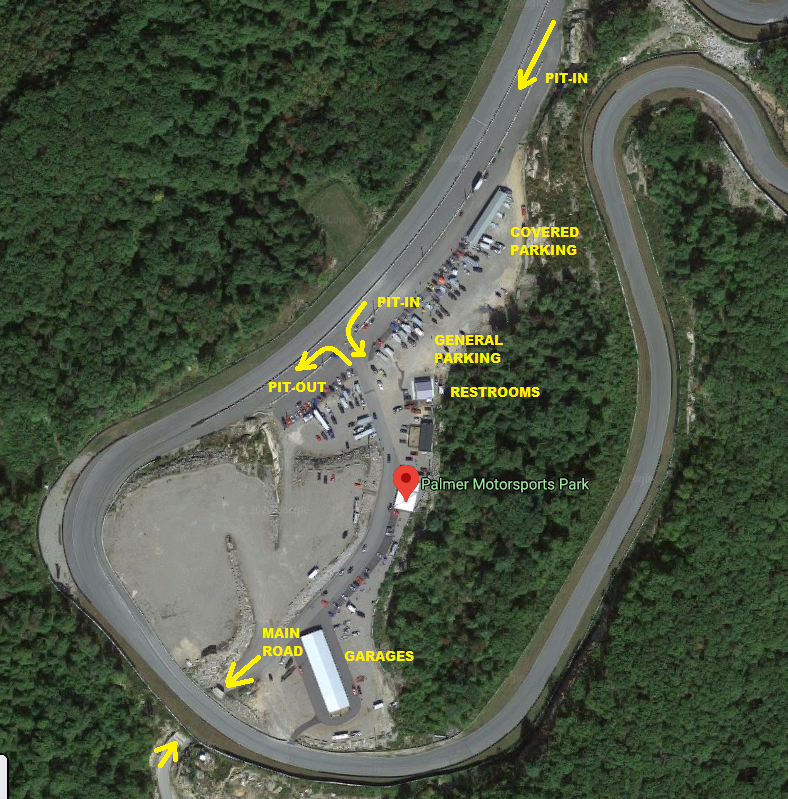
Palmer Motorsports Park is an operating motorsports park in Hampden County, Massachusetts, located at the intersection of West Ware Road and Bacon Road in the town of Palmer. The creation of the track was approved by Palmer on December 4, 2007. The Whiskey Hill Raceway at Palmer Motorsports Park features a 2.3-mile road course with 190 feet of elevation. - Learn more on: Wikipedia
NOTE: This is a dynamic page, if this page is not displaying any data, please use the TRACK GUIDE menu to reselect this venue!
| Travel Guide | Turn-by-Turn |
Passing Zones
Note: All passing zone data depicted below is based on "advanced driver" rules, if you are in a different run group please consult your organization or chief instructor for passing zones that are appropriate for your run group.
No Passing Zone information is currently available.Turn-by-Turn
- Turn 1: This is a fast blind uphill left hander that resembles NJMP Lightning turn 1.In low power cars, because the braking zone and the turn entry are uphill, very little braking is necessary for this turn considering it follows the main straight.The turn should be approached on the right side of the track parallel to the track edge. In order to do so, the car should come all the way out left to the wall at some point on the main straight and stay next to the wall on the left until the following entry trajectory can be achieved:
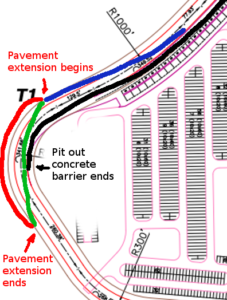 Brake on the right side of the track along the blue line in the diagram in as straight of a line as possible and turn in around where the pavement extension on the right side begins. A moderate amount of trailbraking can work well in this turn, in which case the line would bend into the turn maybe a car length before the pavement extension starts.Low power, high grip cars may be able to hug the right edge of the track all the way through the main straight, which will cut out a good amount of track distance. However, it is still important to rotate the car to be completely parallel to the right edge of the track at the beginning of the braking zone.
Brake on the right side of the track along the blue line in the diagram in as straight of a line as possible and turn in around where the pavement extension on the right side begins. A moderate amount of trailbraking can work well in this turn, in which case the line would bend into the turn maybe a car length before the pavement extension starts.Low power, high grip cars may be able to hug the right edge of the track all the way through the main straight, which will cut out a good amount of track distance. However, it is still important to rotate the car to be completely parallel to the right edge of the track at the beginning of the braking zone.
The apex in turn 1 is the end of the concrete wall where the pit lane merges onto the track. The track following the apex is invisible due to the wall, and the track falls away making the exit tricky still even when apex is properly achieved.
Less experienced drivers can track out to track center line and follow it until the entry into turn 3 can be seen. More experienced drivers carrying more speed in turn 1 will be tracking out all the way right to the point where the pavement extension on the right side ends.
Medium Power Cars
As the car's horsepower increases, it becomes more difficult to line up the car with the right edge of the track while braking. Medium power cars have to brake while turning to run the low power line.
Entry from the right edge of the track is still the best for lap time, and should thus be strived for. A medium power car may be able to pull off the low power line if it has good suspension, is stable (tends to understeer) under braking and has a racing seat to firmly hold the driver.
Medium power cars will need to run what feels like a late apex line through turn 1, because track width at the exit is limited. Patience with turn in is key.
High Power, Low Grip Cars
Drivers of high power cars who are not able to brake and turn at the same time, as well as drivers new to Palmer, often choose to run the following line:
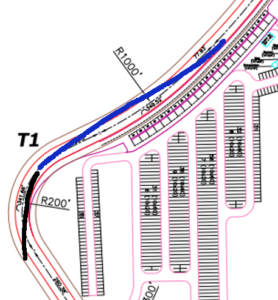
Braking starts earlier on this line and the braking zone is a straight line. Unfortunately the track keeps turning right, which puts the turn in point either in the middle of the track or on the left side of it by the time the driver is finished with braking. Having to turn in from the middle, and especially from the left, makes turn 1 effectively very tight, and hence severely limits the car's speed through it.
The closer drivers of high power cars can come to the low power line, the faster they will generallly be.
- Turn 2: Since the track map referenced in this guide was produced, pavement has been widened between turns 1 and 2 such that turn 2 now is basically the exit of turn 1. This guide follows turn numbering in the track map on top of the page for sanity reasons.
- Turn 3: Fast left sweeper with a blind exit. Vision and consistency are key in turn 3.Set up as far right on the entry as possible. In medium and high power cars, especially those with soft suspensions, this is easier said than done because track surface is off camber on the right side. Good visual reference points to use is a light brown pole on the right side of the track and a black speaker-on-a-pole looking thing that is sitting on the concrete barrier also on the right.Turn 3 is a late apex corner, slightly so in lower power cars and and significantly so in higher power cars. In rain the apex is even later.Low power cars should be able to take turn 3 under full throttle. A Miata should be on full throttle from the exit of turn 1 to the braking zone in turn 5. Medium power cars may need to breathe off throttle in turn 3 depending on how much grip they have. High power cars will certainly have a hard time fitting into the exit in turn 3 without bleeding some speed off.A good track out reference for turn 3 is the turn in cone for turn 4. Lacking cones, the embankment where the corner worker is between turns 3 and 4 is a good choice.
- Turn 4: An uphill left with a clearly visible exit.In low power cars, this turn can often be comfortably taken under full throttle. Medium power, high grip cars should be able to take turn 4 under full throttle as well. High power cars will need to lift and maybe even brake a little.
- Turn 5: A sharp uphill right reminiscent of Watkins Glen turn 7.In a low power car, the line is to stay quite tight at the entry, brake deep in the turn and try to minimize distance traveled while scrubbing off speed as the car rotates into the turn. Entering this turn from the left edge of the pavement ends up costing time because a low power car just cannot obtain meaningful speed increase going up the hill between turns 5 and 6. In a higher power car it may be beneficial to use a more conventional line.High grip cars will likely benefit from hugging the right edge of the track through the entire turn. Medium to low grip cars will have to come out toward track center somewhat between the apex of turn 5 and the turn in point for turn 6.
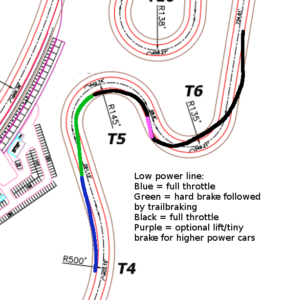 Some cars may be better off entering turn 5 in the middle of the track and straddling track centerline halfway into turn 5. The pavement texture is different between track center and the right edge and some tires are happier in the center.Turn 5 is generally low grip and even 100 hp cars can perform burnouts in it.
Some cars may be better off entering turn 5 in the middle of the track and straddling track centerline halfway into turn 5. The pavement texture is different between track center and the right edge and some tires are happier in the center.Turn 5 is generally low grip and even 100 hp cars can perform burnouts in it. - Turn 6: A sharp uphill left.Low power cars like Miatas should be taking this turn under full power because they are not gaining speed up the hill despite the driver's best efforts. Regardless of the car, the goal in turn 6 is to get on throttle as early as possible and stay on it. In just about everything it is also a good idea to enter the turn from the right side of the track between turns 4 and 5, sacrificing the line and/or the speed in turn 5 as necessary.Although the texture of the pavement is different between track center and the "conventional" line which transitions from track right to all the way left at the apex to track right again, with track center offering more grip, in turn 6 it does not seem to be worthwhile to follow the centerline.Many cars have traction issues in at the exit of turn 6. As of September 2015 the pavement just before the crown past the apex looks like it was grooved, and there is a distinct slick spot there. Keeping the car straight through the slick spot is worthwhile - potentially enough to take a wider approach to turn 6, staying right longer when exiting turn 5, so that the exit of turn 6 is more straight and hence the car is able to put down the power better. A limited slip differential helps greatly in this turn.
- Turn 7: A pretty quick right hand sweeper not unlike the entry to Watkins Glen turn 5.Less experienced drivers tend to run a later apex line which has them come out of turn 6 into turn 7 on the right side of the track. More experienced drivers can run an earlier apex line which exits turn 6 close to the left edge of the track.Low power cars should not need to brake for turn 7. A lift may be needed still to get the front tires to bite for the turn. Medium power cars will need to apply light braking depending on their suspension and grip level, with high power cars certainly needing to brake for turn 7.An interesting feature of turn 7 entry is the crown of the road. Crossing the crown unloads the tires right when maximum grip is demanded - hence, it may be faster to keep the car over the crown, or even slightly to the right of it, on entry to avoid unloading the tires.
- Turn 8: A very long, very late apex downhill sweeper. This turn is a longer and wider version of the second half of Watkins Glen turn 5.The right half of pavement is noticeably off camber.There is an area which is banked more heavily compared to the rest of the turn roughly 2/3 of the way betwee n the middle between the turn in point and the apex. Hitting this additional banking will make a big difference in how much rotation the car is able to accomplish past the apex - and in turn, how much speed the car would be able to carry at the apex.Approach to turn 8 should be a straight line. After hitting the apex in turn 7, run a diagonal right to left straight line toward the point on the left edge of the track which is farthest out. Depending on the car's horsepower and hence attained speed, brake around when the car arrives at the left edge of the track. In a low power car, keep going roughly straight and aim for the beginning of the catch fence on the outside of the track. When the car crosses over the crown in the middle of racing surface, turn in. In a medium power car, follow the same principle but aim at the corner station. A high power car will need a later apex still. High grip cars can turn in earlier and still fit into the exit.Track out point is the end of pavement extension on the right, although it is advised to look uphill toward the entry for turn 9 rather than at the end of the pavement extension.
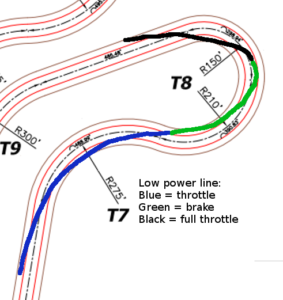
- Turn 9: A fast uphill left hander that should be taken under full power in low power and medium power, high grip cars. High power cars will be going too fast to fit into the exit under full throttle. This turn, as turn 3, requires looking far out at where the car is going to be rather than immediately in front of the car. Allow the car to track out right as much as it wants to - but do not drive out right on purpose - and continue turning left to set up on the left edge for the track for turn 10. The exit of turn 9 is very similar to Summit Point Main exit of turn 5.Car position at the apex of turn 9 makes a big difference in the line in the second half of the corner. I aim to hang the left frcont tire off the pavement a bit when I turn in, and that puts me very close to the edge of the pavement. Many drivers give up feet of track width at the apex, which especially in high power cars makes the car want to fly off track at the exit.
- Turn 10: A downhill banked right hander with a very late apex.A good approach in this corner is to aim at the end of the trees righ tof the end of the stone embankment past the track which I marked by the blue squiggles on the diagram below. The green line is a compromise between straight line braking and rotating the car so that it turns with the track. I came out about 3/4 of track width by the turn in point; less experienced drivers traveling at lower speeds generally were completely on the outside at the turn in point. Black line should be taken under full throttle as there is a meaningful straight between turns 10 and 11.Turn 10 requires a fine application of trailbraking. On one hand, aggressive trailbraking will rotate the car which is exactly what is desired in this turn. The pavement seems slicker here than in other corners which calls for more trailbraking. However, it seems that with excessive trailbraking the car just goes straight while rapidly decelerating, and this is not at all wanted. The right combination of delaying braking until as late as possible while approaching the corner, braking at the maximum possible torque and lingering on the brakes while steering will provide the best speed through this corner.
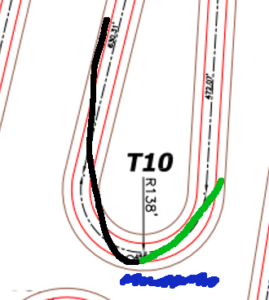
- Turn 11: In a low power car I consider turn 11 as a part of the preceding straight with the goal being to stay on throttle as long as possible and use track width in turn 12 and between turns 12 and 13 to set up for turn 13:
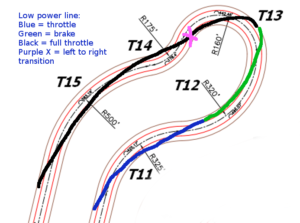
As of September 2015 there is a dip on the approach to turn 11. Cars with softer (street) suspensions are unlikely to feel it, however stiffly spring cars at full tilt unmistakably experience it. Fortunately the dip is not very deep, and in lower powered cars it may not affect the line much at all.A popular line through turn 11 is a late apex. Especially if the track is coned with a late apex line through 11 drivers may drive cone to cone in this section. There is no straight between turns 11 and 13 though thus a late apex in turn 11 is generally wasted. - Turn 12: Continuing to refer to the above diagram for turn 11, I use turn 12 to set up for turn 13. I start braking around the apex of turn 12 while straightlining the corner, and bring the car to the right edge of the track around the turn in point for turn 13.I aim for the beginning of the catch fence on the outside of the track for my turn in point. With more grip in the car I have had good results with hugging the left edge of the track in turn 12 and straightening as soon as I was lined up with the beginning of the catch fence.Higher power cars will want to run a later apex in turn 12, aiming even further past the beginning of the fence. Higher grip cars may be able to rotate the car appropriately without coming out to the right edge of the pavement; lower grip cars will generally benefit from turning in from far right.
- Turn 13: Turn 13 is where the main straight begins for lower powered cars. As such this corner is all about a late apex and conservative entry.Good reference points for turn 13 entry are the light on the right side of the track and the catch fence following the light. The car should be pretty close to the right edge of the track to achieve the best line through turns 13 and 14.
- Turn 14: Turn 14 forms an "esses" section with turn 13. Turn 14 reminds me of the left hander in the Snake at VIR.The key in turn 14 is to have the least amount of steering input and the highest possible apex speed. The track opens up in turn 15 such that at least low to medium power cars should have no issue fitting into the track past turn 14 provided they fit into turn 14.Stiffer cars may find turn 14 challenging because it has enough elevation change to nearly lift wheels off the pavement. Limited slip differential would again help here, as would also likely do aero.Compare the above diagram of turns 11-14 complex to the below diagram of how many drivers traverse the same section:
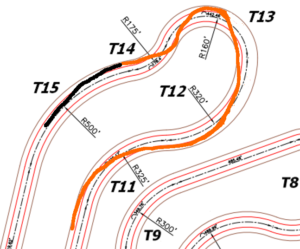
Here, turns 11, 12, 13 and 14 are all taken as late apexes. The end result is much more direction change between turns 13 and 14, leading to much lower speed in that section. Drivers who take the orange line normally find themselves not needing to use the entire track width in turn 15 - another sign of dramatically lower exit speed in turn 14. Furthermore, there are no straights to accelerate on between turns 11 and 14, leading these drivers to lose time in that part of the course as well. - Turn 15: In low to medium horsepower cars turn 15 is a non-event.
Turn-by-Turn Information provided by

©2018 - Oleg Pudeyev / Race & Track Driving ; with Permission.
